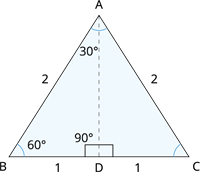PDF chapter test TRY NOW
Consider an equilateral triangle \(ABC\) with sides measuring \(2\) units.
That is \(AB\) \(=\) \(BC\) \(=\) \(CA\) \(=\) \(2\) units.
Draw a bisector of \(\angle A\) such that it meets \(BC\) at \(D\).
The angle bisector of an equilateral triangle also bisects the side opposite it.
So, \(BD\) \(=\) \(DC\) \(=\) \(1\) unit.

First, let us calculate the measure of angle bisector \(BD\) in the figure.
Consider the triangle \(ABD\).
Since the given triangle is a right-angled triangle by the Pythagoras theorem, we have:
In a right angled triangle, \(\text{Hypotenuse}^{2} = \text{Adjacent side}^{2} + \text{Opposite side}^{2}\).
\(AB^2\) \(=\) \(BD^2\) \(+\) \(DA^2\).
\(DA^2\) \(=\) \(AB^2\) \(-\) \(BD^2\)
\(DA^2\) \(=\) \(2^2\) \(-\) \(1^2\)
\(DA^2\) \(=\) \(4 - 1\)
\(DA^2\) \(=\) \(3\)
\(\Rightarrow DA\) \(=\) \(\sqrt{3}\)
Therefore, for the considered right-angled triangle, we have:
| With respect to \(30^{\circ}\) | With respect to \(60^{\circ}\) |
| Opposite side \(=\) \(1\) units | Opposite side \(=\) \(\sqrt{3}\) units |
| Adjacent side \(=\) \(\sqrt{3}\) units | Adjacent side \(=\) \(1\) units |
| Hypotenuse \(=\) \(2\) units | Hypotenuse \(=\) \(2\) units |
Now, let us determine all the trigonometric ratios of \(30^{\circ}\) and \(60^{\circ}\).
- Sine:
\(\sin 30^{\circ}\) | \(\sin 60^{\circ}\) |
\(\sin 30^{\circ}\) \(=\) \(\frac{\text{Opposite side}}{\text{Hypotenuse}}\) \(=\) \(\frac{1}{2}\) | \(\sin 60^{\circ}\) \(=\) \(\frac{\text{Opposite side}}{\text{Hypotenuse}}\) \(=\) \(\frac{\sqrt{3}}{2}\) |
- Cosine \(30^{\circ}\):
\(\cos 30^{\circ}\) | \(\cos 60^{\circ}\) |
\(\cos 30^{\circ}\) \(=\) \(\frac{\text{Adjacent side}}{\text{Hypotenuse}}\) \(=\) \(\frac{\sqrt{3}}{2}\) | \(\cos 60^{\circ}\) \(=\) \(\frac{\text{Adjacent side}}{\text{Hypotenuse}}\) \(=\) \(\frac{1}{2}\) |
- Tangent:
\(\tan 30^{\circ}\) | \(\tan 60^{\circ}\) |
\(\tan 30^{\circ}\) \(=\) \(\frac{\text{Opposite side}}{\text{Adjacent side}}\) \(=\) \(\frac{1}{\sqrt{3}}\) | \(\tan 60^{\circ}\) \(=\) \(\frac{\text{Opposite side}}{\text{Adjacent side}}\) \(=\) \(\frac{\sqrt{3}}{1}\) \(=\) \(\sqrt{3}\) |
Using these basic trigonometric ratios determine their reciprocals as follows:
- Cosecant:
\(\text{cosec}\,30^{\circ}\) | \(\text{cosec}\,60^{\circ}\) |
\(\text{cosec}\,30^{\circ}\) \(=\) \(\frac{1}{\sin 30^{\circ}}\) \(=\) \(\frac{2}{1}\) \(=\) \(2\) | \(\text{cosec}\,60^{\circ}\) \(=\) \(\frac{1}{\sin 60^{\circ}}\) \(=\) \(\frac{2}{\sqrt{3}}\) |
- Secant:
\(\sec 30^{\circ}\) | \(\sec 60^{\circ}\) |
\(\sec 30^{\circ}\) \(=\) \(\frac{1}{\cos 30^{\circ}}\) \(=\) \(\frac{2}{\sqrt{3}}\) | \(\sec 60^{\circ}\) \(=\) \(\frac{1}{\cos 60^{\circ}}\) \(=\) \(\frac{2}{1}\) \(=\) \(2\) |
- Cotangent:
\(\cot 30^{\circ}\) | \(\cot 60^{\circ}\) |
\(\cot 30^{\circ}\) \(=\) \(\frac{\text{1}}{\tan 30^{\circ}}\) \(=\) \(\frac{\sqrt{3}}{1}\) \(=\) \(\sqrt{3}\) | \(\cot 60^{\circ}\) \(=\) \(\frac{\text{1}}{\tan 60^{\circ}}\) \(=\) \(\frac{1}{\sqrt{3}}\) |
Let us summarize all the trigonometric ratios of \(30^{\circ}\) and \(60^{\circ}\) in the following table.
\(\sin \theta\) | \(\cos \theta\) | \(\tan \theta\) | \(\text{cosec}\,\theta\) | \(\sec \theta\) | \(\cot \theta\) | |
\(\theta = 30^{\circ}\) | \(\frac{1}{2}\) | \(\frac{\sqrt{3}}{2}\) | \(\frac{1}{\sqrt{3}}\) | \(2\) | \(\frac{2}{\sqrt{3}}\) | \(\sqrt{3}\) |
\(\theta = 60^{\circ}\) | \(\frac{\sqrt{3}}{2}\) | \(\frac{1}{2}\) | \(\sqrt{3}\) | \(\frac{2}{\sqrt{3}}\) | \(2\) | \(\frac{1}{\sqrt{3}}\) |
